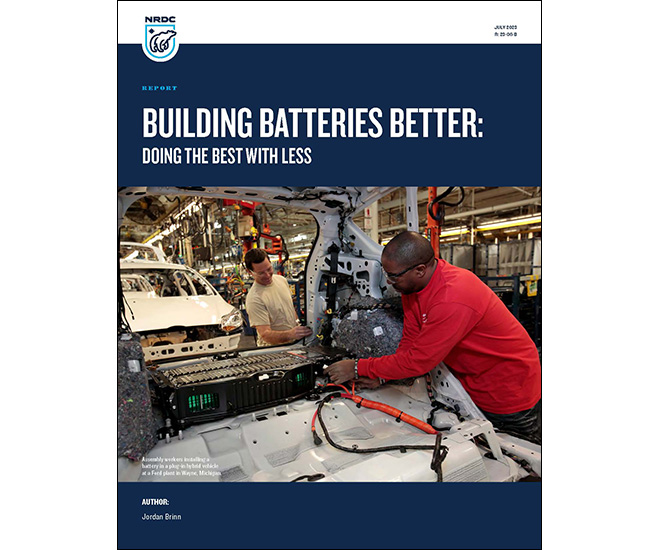The authors of the endless articles warning of the environmental costs of battery raw materials are invariably “big fans” of EVs, but they’re naturally concerned that they may not be “as green as they claim.”
Oddly, these public-spirited citizen journalists never mention the far greater environmental impacts of fossil fuel extraction, nor do they seem to consider the fact that e-mobility supporters are in the business of reducing environmental damage, whereas the oil and gas industry has amply demonstrated its indifference to the issue. As demand rises for battery raw materials, EV industry players are working to reduce the environmental costs of extraction.
Ironically, the fact that building batteries causes environmental stress could serve as a catalyst to make the dirty mining industry clean up its act. That’s one of the conclusions of a new report from the Natural Resources Defense Council.
The new paper (which policymakers and battery industry execs may want to read in its entirety) describes the real-world environmental and social costs of mining processes. However, unlike those thinly-veiled anti-EV screeds, it offers detailed recommendations for addressing the problems.
“Mineral mines can contaminate surrounding waters and ecosystems, jeopardize the health and safety of local communities and workers, and run roughshod over sacred Indigenous lands,” writes author Jordan Brinn. “But EV batteries did not create this problem, and are far from the only products that require mined materials. Minerals are in…cell phones, home appliances, and even…the buttons and zippers on pants and jackets.”
Brinn addresses the EV-bashers’ main logical fallacy head-on: “EVs will always be a more environmentally friendly choice than fossil fuel-powered cars simply because they do not rely on continuous fossil fuel extraction, which has destroyed aquifers, polluted the air, and harmed the health of so many people over the past century. In 2021 alone, the US transportation sector used 4.86 billion barrels of oil. Once this oil is burned, it is gone forever. Conversely, an old EV battery is essentially a small mineral reserve filled with extremely concentrated and high-quality materials like lithium and nickel that can be reused again and again.”
“Transitioning to EVs creates an opportunity to reduce long-term reliance on extractive industries that will never be an option for fossil fuel vehicles,” Brinn continues. “We need to mine minerals for EVs, but we need to do it right. As we ramp up the production and processing of minerals to meet clean energy needs over the coming years, regulators and industry will need to implement new strategies and policies, such as improved waste management, cleaner extraction technologies, and community engagement and consent for siting that will reduce the impacts of mining as much as possible.”
The NRDC paper focuses on the most effective, and most logical, strategy to limit the damage from battery supply chains: using less minerals. “While there are many actions that will reduce the harmful impacts of extracting minerals, these harms cannot be fully mitigated because extraction inherently requires some level of energy, land and chemical use.”
Brinn notes that the US government has taken steps toward building environmentally responsible EV battery supply chains through the Bipartisan Infrastructure Law and Inflation Reduction Act, but says “not enough of the funding in this legislation—or strategic planning—is currently going toward reducing the amount of minerals we need.”
The NRDC identifies three strategy areas for building a lower-impact and more circular battery supply chain:
- Decreasing reliance on difficult-to-access critical minerals through technological improvements. The DOE’s Advanced Materials and Manufacturing Technologies Office should direct funding toward improving material efficiency in EV battery manufacturing; the EPA should make batteries a specific category in prize programs such as its Green Chemistry Challenge and in the ecolabel certifications it funds; and DOE should continue to award grants through BIL to commercial scaling of improved battery chemistries.
- Extending EV battery life spans through second-life applications. For example, EPA and the DOT should create a separate category for used batteries within their hazardous waste regulations to reduce unnecessary barriers and costs to reuse (and recycling); EPA should enforce national battery labeling requirements based on the Global Battery Alliance’s Battery Passport through the Resource Conservation and Recovery Act; and DOE’s Vehicle Technology Office should explore opportunities to expand funding for battery health testing and second-use research and commercial scaling.
- Closing the loop: recycling, end-of-life, and recycled materials markets. DOE should expand funding for the ReCell Center’s research on battery recycling methods that minimize impacts and maximize recovery rate; the State Department should include batteries as one of the next sectors of focus for the First Movers Coalition to encourage public-private collaboration on battery supply chain issues; EPA should set recovery rate targets for battery recycling like those in the EU Sustainable Batteries law and require that all EV batteries be recycled; and DOE should prioritize high recovery efficiencies in its selection criteria for BIL grants.
“All of these actions that support more efficient use of minerals and decrease the need for mining must occur in parallel with much-needed mining reform,” writes Brinn. “The task before us is to produce the minerals we need for a cleaner economy in the best way possible so that we can, once and for all, put the harms from fossil fuels in the rearview mirror.”
Source: NRDC


















































































